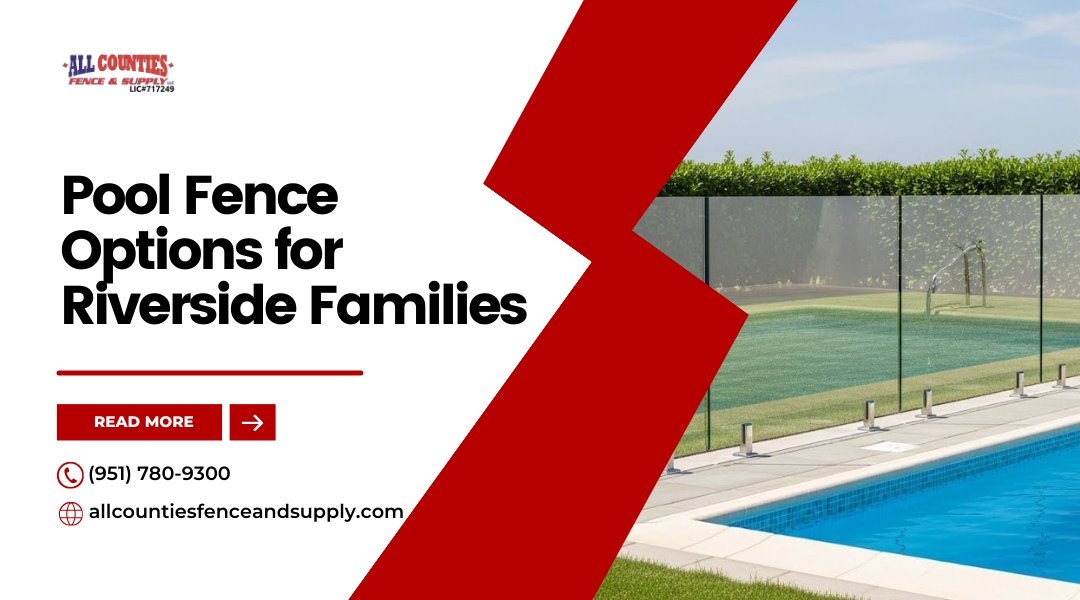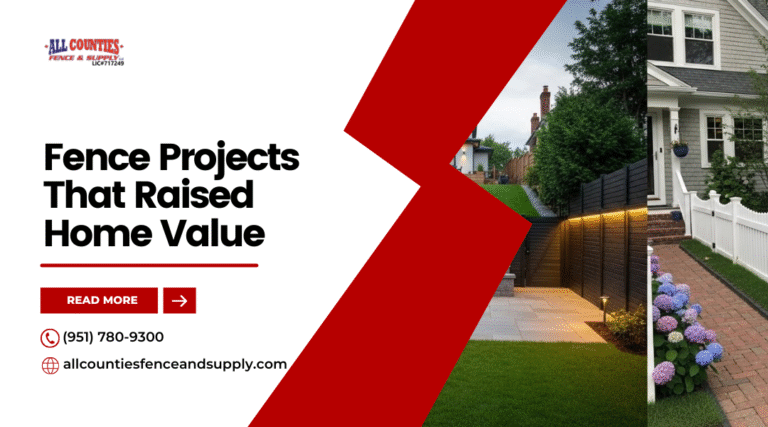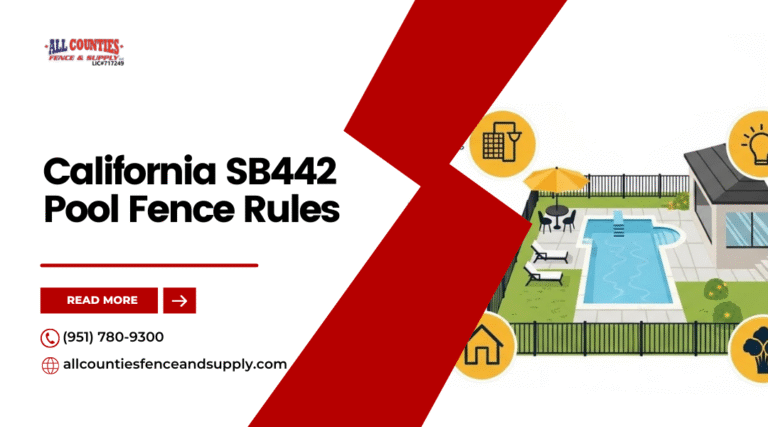A swimming pool can be the highlight of your backyard, but keeping kids safe around it always comes first. Choosing the right fence helps prevent accidents while maintaining your yard’s appearance. In Riverside, you can pick from several reliable options—mesh, iron, glass, and more—to protect your family and stay within local pool safety standards.
You’ll find that each type of fence offers different benefits. Mesh fences are lightweight and removable, iron fences bring strength and style, and glass fences create a modern look with clear sightlines for better supervision. The right choice depends on your home’s design, safety needs, and budget.
As you explore your options, you’ll also want to understand how Riverside’s pool safety and fencing regulations apply. Knowing these details helps you make an informed decision and ensures your pool area meets standards designed to protect children and give you peace of mind.
Pool Safety and Family Protection
Installing a secure pool fence reduces the risk of child drownings and prevents unsupervised access to the water. You can strengthen your home’s safety by combining durable fencing with close supervision and smart safety planning that fits your family’s daily routine.
Why Pool Fencing Is Essential for Homes With Children
A proper pool fence provides a physical barrier between your children and the water. Drowning is one of the leading causes of accidental death for young children, and even a few seconds of unsupervised access can be dangerous. Local building codes in Riverside generally require barriers at least 4–5 feet tall with self-closing, self-latching gates that open away from the pool.
Choose materials that resist climbing and weather damage. Mesh and aluminum fencing are popular because they prevent footholds while maintaining visibility. Glass panels give a clear line of sight for supervision but must be installed with strong anchors and tempered glass for safety. Wrought iron offers strength and long life when fitted with close pickets under 4 inches apart.
| Feature | Recommended Standard |
|---|---|
| Minimum Height | 4–5 ft |
| Gate Type | Self-closing, self-latching |
| Gap Width | Under 4 in |
| Opening Direction | Outward from pool |
Layers of Protection and Supervision
A fence is only one layer of pool safety. You should combine it with pool alarms, door sensors, and active supervision. Safe habits—like designating an adult “water watcher” during playtime—reduce the chance of accidents.
Teach your children basic swimming and water survival skills early. Keep rescue equipment such as a pole and flotation ring close to the pool. Regularly inspect and maintain all safety devices, including hinges and latches, to ensure they function properly.
Adding clear boundaries and consistent oversight helps minimize risks. These combined steps create a safer pool area for your family while allowing you to enjoy outdoor activities with peace of mind.
Understanding Riverside Pool Fence Regulations
You must follow Riverside’s specific pool safety laws to keep your swimming area secure and meet local standards. To prevent accidents, especially involving children, the city and state require barriers that meet detailed height, material, and gate operation rules.
Legal Requirements for Pool Barriers
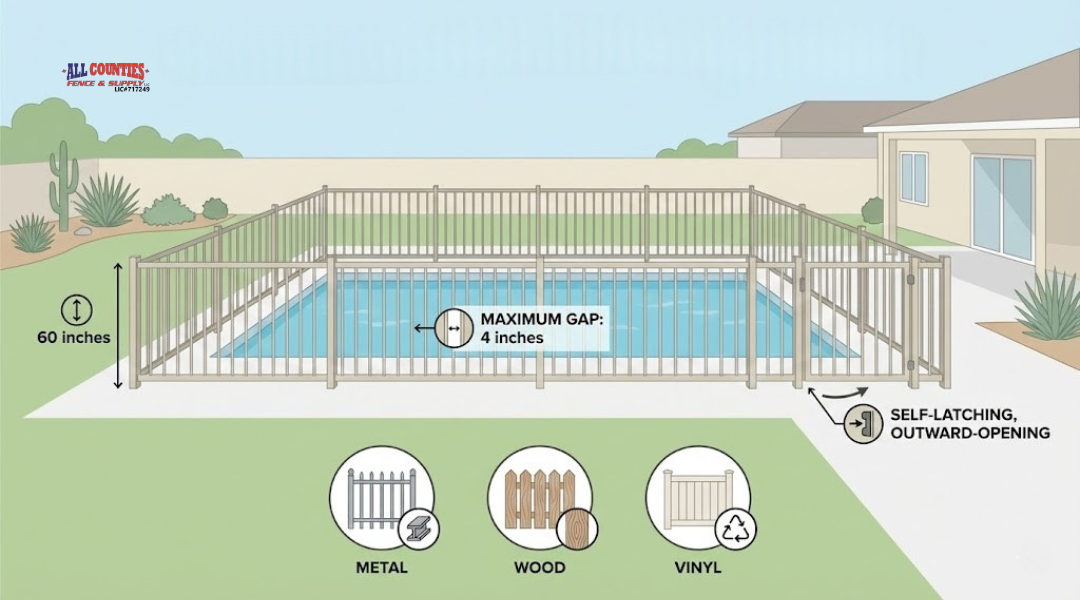
In Riverside, any residential pool or spa that holds more than 18 inches of water must be surrounded by a fence or barrier at least 60 inches tall. The barrier must fully enclose the pool area and block direct access from the home or yard.
The maximum gap between the fence bottom and the ground cannot exceed 2 inches on soft ground or 4 inches on solid surfaces such as concrete. Openings in the fence must be small enough that a 4-inch sphere cannot pass through. Mesh, iron, vinyl, and tempered glass are allowed when properly installed and maintained.
Certain homes built after California’s pool safety act update may also need additional safety measures like door alarms, safety covers, or removable barriers. These help create multiple layers of protection for children and pets.
| Requirement | Specification |
|---|---|
| Minimum Height | 60 inches |
| Max Gap at Bottom | 2–4 inches |
| Max Opening Size | 4 inches |
| Applies To | Pools ≥ 18 in. deep |
Permit Process and Local Compliance
Before starting installation, you must apply for a building permit through Riverside’s Building & Safety Division. A permit ensures your pool fence design meets state and municipal codes. You’ll need to provide details about materials, layout, gate placement, and barrier heights.
City inspectors review your plan and will conduct a final inspection once the fence is built. This inspection confirms compliance with California Building Code Section 305 and Riverside Municipal Code Chapter 16.19.
If your property is in a gated community or under an HOA, review any association rules that may set extra design or material guidelines. These may affect fence color, visibility, or style, especially for iron or glass installations.
Self-Closing and Self-Latching Gate Standards
Every gate giving access to your pool area must open outward, away from the water, and be both self-closing and self-latching. The latch should be placed at least 54 inches above ground level or designed so that small children cannot easily reach it.
Gates must remain closed and latched when not in use to meet inspection standards. For added safety, consider child-resistant latches that require dual-action mechanisms to open. Spring hinges, magnetic latches, or mechanical closers help ensure the gate shuts automatically after each use.
You should also check your gate regularly for loose fittings or wear. A poorly aligned latch or weak spring can make your fence noncompliant and reduce your pool safety protection.
Popular Pool Fence Options for Families With Kids
Installing a child-safe pool fence helps prevent unsupervised access and meets local safety codes. The best materials balance durability, visibility, and maintenance needs while fitting the look of your home and yard.
Mesh Pool Fences: Safety and Flexibility
Mesh pool fences use tightly woven fabric panels supported by aluminum poles. The mesh creates a non‑climbable, see‑through barrier that blocks access while keeping open views of the water. You can remove or reinstall sections easily when hosting guests or doing maintenance.
These fences usually include self‑closing, self‑latching gates that lock automatically. They resist rust, tearing, and UV damage, which makes them practical in Riverside’s sunny climate. Because mesh fences are modular, you can shape them around irregular pool layouts or existing walls.
Many brands offer poles reinforced with stainless steel or fiberglass for extra strength. You can expect minimal upkeep—an occasional rinse and tension check keep the fence secure and looking clean.
Iron Pool Fences: Durability and Design
Iron pool fences, often made from wrought or powder‑coated steel, add strong permanent protection that lasts for decades when properly treated. The metal’s weight and rigidity create a solid barrier that resists impact and weather exposure.
These fences come in decorative styles, such as vertical pickets with narrow spacing to stop climbing. A self‑latching gate should be positioned high enough to stay out of children’s reach. Choose designs with smooth top rails instead of spear points for added safety around kids.
Routine maintenance involves removing rust spots and repainting every few years. If you prefer a low‑upkeep alternative, aluminum fencing offers similar looks without corrosion concerns. Iron remains a top option for families who want classic appearance and permanent structure.
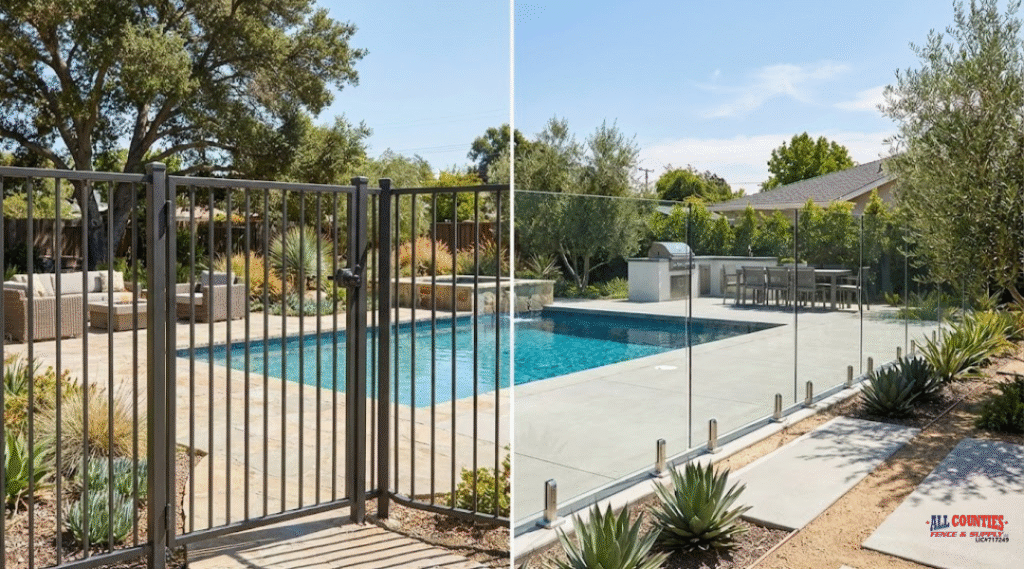
Glass Pool Fences: Modern and Unobtrusive Barriers
Glass pool fences use tempered glass panels four to five times stronger than standard glass. They provide a clear view of the pool while forming a solid safety barrier. The transparency helps you keep watch over kids from the patio or kitchen.
You can select frameless systems for minimal visual impact or semi‑framed styles with slim metal posts. Proper installation is key—panels must be firmly anchored to meet safety standards.
Maintenance involves cleaning the panels with mild soap or glass cleaner to remove water spots. Hardware should be inspected yearly to ensure hinges and latches stay tight. While the upfront cost is higher than mesh or metal, glass fencing offers lasting durability and modern appeal.
Removable and No-Holes Pool Fence Systems
Removable and no‑holes pool fences give flexibility without permanent drilling. Poles rest in weighted bases, and the mesh panels connect between them. You can install or remove the entire system within minutes—ideal for renters or families who use the pool seasonally.
These systems maintain child‑safety features like self‑closing gates and latch locks. Despite being portable, they can meet local pool safety requirements if secured correctly and properly tensioned.
Materials often mirror traditional mesh fencing, using UV‑resistant fabric and rust‑proof hardware. Regular inspection ensures bases remain stable and gaps stay tight. This option suits homeowners wanting a balance between safety and convenience without altering deck surfaces.
Choosing the Best Pool Fence for Your Home
Selecting the right pool fence involves balancing safety, cost, appearance, and maintenance. The best choice depends on how old your children are, the shape and layout of your pool, and how much time and money you can invest in upkeep.
Key Factors: Age of Children, Pool Layout, and Budget
Younger children need fences with self-closing, self-latching gates and no horizontal features that allow climbing. Mesh and aluminum fences often meet these standards and provide clear visibility for supervision. For older kids, durability may take priority, so materials like iron or vinyl can offer a stronger, more permanent barrier.
Your pool layout influences design and installation. A raised deck or irregular pool shape may make a flexible mesh fence easier to fit. Glass or aluminum fences suit flat patios where alignment and symmetry matter.
Cost plays a major role. Here’s a simplified price range for common materials (per linear foot):
| Material | Typical Cost | Maintenance Level |
|---|---|---|
| Mesh | $15–$30 | Low |
| Aluminum/Iron | $25–$45 | Moderate |
| Glass | $40–$75 | Low |
| Vinyl | $20–$40 | Low |
| Wood | $15–$35 | High |
Align your budget with long-term value rather than short-term savings.
Comparing Safety Features and Maintenance
A safe pool fence must block unsupervised access while staying easy for adults to use. Height, gap spacing, and gate design are key. Gates at least 48 inches high with child-resistant locks reduce risks for families with toddlers. Vertical bars spaced no more than 4 inches apart prevent climbing.
Maintenance varies. Mesh fences resist rust and fade, while glass options only require periodic cleaning. Aluminum and iron need repainting to prevent corrosion. Wood must be sealed or stained yearly. Choose a fence that matches your ability to maintain it, as a poorly kept barrier loses both function and appearance.
If your region has strong sun or moisture, look for UV-resistant and rust-proof materials. In Riverside’s dry climate, aluminum and vinyl perform well year-round.
Aesthetic Considerations and Landscape Integration
The right fence should protect your family without clashing with your yard. Glass fences preserve views and make small areas look open. Iron and aluminum fences suit traditional or modern homes due to their slim profiles and durable finishes. Vinyl offers privacy and works well near family patios.
Blend your fence with your landscaping for a consistent look. Match colors to trim or outdoor furniture, and use greenery or planters to soften the barrier’s outline. For a natural yard, treated wood or muted-tone aluminum can help the fence blend with shrubs, stone, or turf.
Consistency between your pool fence, decking, and lighting keeps your outdoor area safe while maintaining visual harmony.
Pool Fence Installation and Maintenance in Riverside
Installing and maintaining a pool fence in Riverside helps you meet safety laws, prevent accidents, and extend the life of your fencing. Choosing trained installers and performing routine care can reduce long-term costs and improve overall safety for your family.
Professional Installation vs. DIY
In Riverside, professional pool fence installation services such as Life Saver Pool Fence, Pool Defence, and Guardian Pool Fence provide certified installers familiar with California safety codes and ASTM standards. They ensure proper fence height, gate locks, and spacing to meet safety regulations. A licensed installer can also guide you on materials like mesh, iron, or glass that suit Riverside’s warm climate and match your yard’s design.
DIY installation kits are available, but they often require tools, precise measurements, and a solid understanding of barrier rules. Mistakes such as uneven posts or loose latches can weaken the fence and affect compliance.
If you prefer to save time and ensure reliability, hiring a local professional is usually the safer choice. For smaller repairs or temporary setups, DIY can work when you follow manufacturer guides strictly and double-check local compliance requirements.
Routine Fence Inspections and Repairs
Conducting routine inspections protects your investment and ensures continued safety. Check for issues such as:
| Problem | What to Look For | Action |
|---|---|---|
| Loose posts | Shifting at base | Tighten or reset |
| Worn mesh or panels | Tears, cracks, rust | Replace damaged sections |
| Faulty gates | Difficult latching or gaps | Adjust hinges, test locks |
Inspect your pool fence every few months, especially after wind, storms, or heavy use. Riverside’s sun and heat can cause fading or warping, so cleaning and applying protective coatings can prevent long-term damage.
Keep hardware rust-free, and confirm gates self-close and self-latch properly. Quick attention to small problems will help your fence remain strong, secure, and compliant with local safety rules.
Additional Pool Safety Solutions
In addition to fences, you can strengthen pool safety by adding reliable barriers and teaching everyone how to act safely near water. Modern technology and clear household routines make a noticeable difference in reducing accidental risks.
Pool Safety Covers and Alarms
Safety covers give you a secure way to block access to the pool when it’s not in use. You can choose between manual, automatic, or mesh styles, depending on your budget and pool type. A properly fitted cover must support weight and lock in place to prevent children or pets from slipping under it.
Pool alarms serve as an extra layer of warning. Options include:
- Surface wave alarms that detect water movement
- Gate alarms that sound when the gate opens
- Wearable wrist alarms for children
Selecting alarms that meet ASTM safety standards improves reliability. Regular testing and battery replacement ensure the systems stay ready. While covers and alarms cannot replace supervision, they help close the gaps that occur when you step away, even briefly.
Establishing House Rules and Safety Education
Rules help everyone understand boundaries around the pool. Start with simple, enforceable guidelines such as no running, no swimming alone, and always close the gate. Post the rules near the pool where they are easy to see.
Teach children how to enter and exit the water safely and what to do if they see someone in trouble. Enroll them in swimming lessons that include water survival skills. Adults in your household should know CPR and basic rescue techniques.
Hold occasional family safety meetings to review procedures before pool season begins. By treating safety education as a regular family habit, you build awareness that protects both kids and guests year-round.

